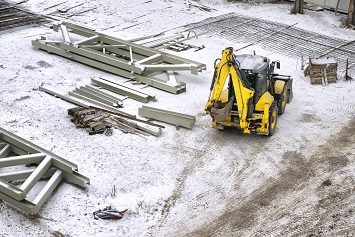If you’re in a cold climate, you probably invest resources and effort into preparing your fleet for winter. But do you give the same attention to heavy equipment in your workplace? Here’s how you can ensure that heavy equipment in your workplace is ready for and operates smoothly and safely throughout the season.
 Cold Weather Care
Cold Weather Care
Your equipment operators probably have a daily inspection checklist that they go through before beginning work. In cold weather, they may need to be aware of some additional information or precautions while they perform their checks. Make sure they know to:
- Check the filters. Dirty or clogged air, fuel, and hydraulic filters can make equipment harder to start and can cause power loss during operation.
- Check the battery. Cold weather causes batteries to discharge more quickly and charge more slowly. Workers should know never to charge or jump-start a frozen battery; wait until the battery warms up to 40 degrees Fahrenheit first.
- Check fluids, hoses, and seals. Freezing temperatures can cause fluids, including hydraulic fluids, to thicken up, which increases the pressure on hoses and seals. Check carefully for any signs of leakage that could indicate a failed line or seal.
- Check the tires. Pneumatic tires may need a little more air to maintain the correct pressure in cold temperatures, and both solid and pneumatic tires should be checked to ensure that the tread is sufficient for winter operating conditions.
- Check the lights and wipers. Both lights and wipers are more important in winter, when light levels are lower and precipitation and condensation can affect visibility. Make sure that they are working properly and that your headlights are clean.
- Check the heater and defroster. Do this especially when it first starts to get cold, since the heater will not have been used in a while.
- Lubricate moving parts. Moving parts can freeze and seize, so make sure that everything is well-oiled in the winter, and keep your coolant—which also functions as a lubricant—topped off.
- Warm up on start up. Hydraulics especially need a chance to warm up, so operators should let equipment idle for a few minutes and then should operate each hydraulic function to circulate the oil.
At the end of the day, workers should take precautions to ensure that their equipment will be ready to go the next morning:
- Clean it up. Salt can damage your equipment, so clean it off at the end of your shift.
- Stay freewheeling. Equipment that sits outdoors overnight or in severe winter weather can freeze to the ground, whether it’s on tires or tracks; when workers go to move it, they can damage it. Park equipment on raised planks, old tires, or some other surface besides bare ground. Raise attachments off the ground, too, while equipment is parked.
Winter Operating Tips
In winter, safety concerns include cold illness (hypothermia) and injury (frostbite), slips on icy surfaces, and vehicle accidents arising from poor visibility and slick operating conditions. Here are some winter-specific tips for heavy equipment operators to prevent accidents and injuries:
- Dress appropriately. If you’re working outdoors, dress warmly. Dress in layers so that you can go from outdoors to indoors, including into and out of a climate-controlled cab, easily. Wear insulated socks and gloves. Be aware of how your clothing affects your hearing, vision, and “feel” for the equipment; you may need to adjust.
- Don’t touch frozen metal surfaces bare-handed. Whether you’re inspecting your equipment or climbing into or out of your cab, make sure you have gloves on; touching frozen metal bare-handed can cause instant injury to the skin.
- Don’t slip. Steps, handholds, and grip plates may be iced and slippery, so be careful climbing into the cab. Be careful climbing out, as well; if your cab is climate-controlled, you may not be thinking about how cold and slick that first step could be.
- Make sure your route is clear. Poor traction can affect heavy equipment just as it can cars, and iced-over areas may hide ditches, edges, and uneven terrain where the ice may not hold your vehicle’s weight. Obstacles and hazards that could damage your equipment may be covered with snow or ice. Be sure to keep any traffic lanes clear of snow and ice as much as possible, and spread grit as needed.
- Slow down. Remind operators that speed decreases their reaction time and increases the severity of any impact, and slick surface conditions will also increase the time and distance needed for turning and stopping. When operating conditions are less than optimal, it’s best to slow down.
- Be especially careful on ramps and bridges. Elevated surfaces are the first to freeze.
- Avoid operating in poor light. If you’re working on an industrial or construction site, your headlights alone may not be enough to show you ground conditions or overhead hazards. If there’s not enough light to see what’s in front of you or above you, ask for more light.
- Take breaks. The colder it gets, the more easily workers will tire. In addition to scheduled breaks, workers should be aware of how the cold is affecting their energy or concentration and should take warm-up breaks as needed. Have warm beverages and healthy snacks available.

Excellent review for operating in climate such as we experience in Western and Northern NY